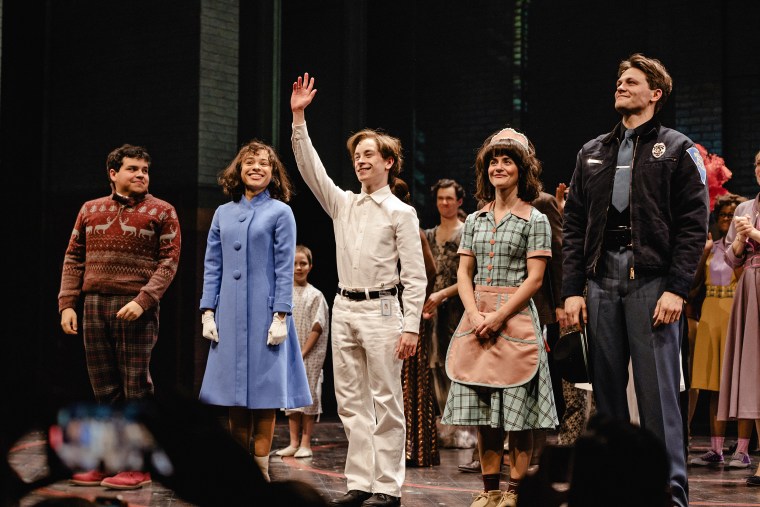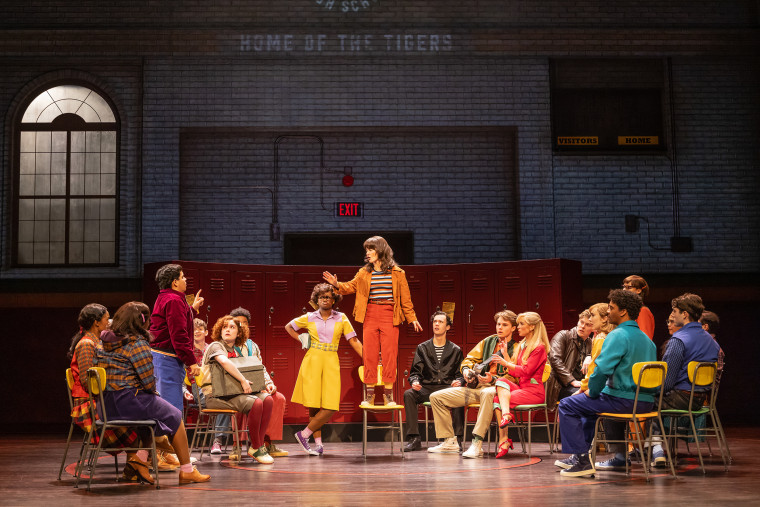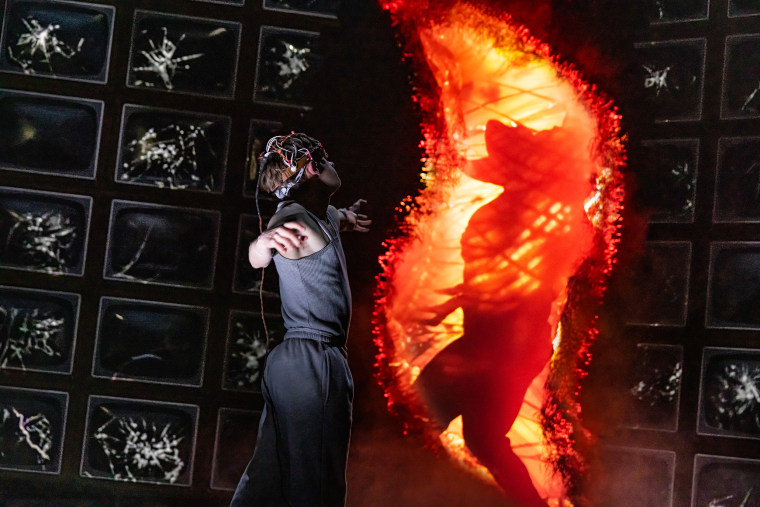
When Louis McCartney first auditioned for “Stranger Things: The First Shadow,” he taped himself reading for a part named George.
The opportunity started as an email in the then 18-year-old’s inbox: an untitled Netflix play, co-directed by Tony Award winner Stephen Daldry. George was described as a young kid, “savagely loyal,” “escaping the shadow” and “living with the spirit of the boy he once was,” McCartney tells TODAY.com.
“That’s all I knew,” he adds.
Two years later, McCartney was at the Tony Awards, nominated for best actor in a play and competing against the likes of George Clooney, winner Cole Escola and more.
“Stranger Things: The First Shadow,” which opened in London’s West End in December 2023 and then hit Broadway April 22, 2025, is a play set in the world of the hit Netflix show, which returns for its fifth and final season in November. “George” turned out to be a young Henry Creel, who was revealed as the big bad of the show’s universe in Season 4.
Henry, played in the series by Jamie Campbell Bower, is also known as One, the first of the powerful children, including Millie Bobby Brown’s Eleven, tested on in Dr. Brenner’s lab in Hawkins, Indiana. Henry was taken under Dr. Brenner’s wing after he murdered his mother and sister using his powers of telekinesis.
Henry was eventually banished to a terrifying parallel universe from which monsters like the Demogorgon and Mind Flayer originate. He transformed into a grotesque, red humanoid monster responsible for unleashing a hellscape onto Hawkins via the Upside Down, which essentially marks the intersection of the real world and that other dimension.

But before Vecna, Henry was a teenage boy starting school at Hawkins High in the late 1950s.
“The whole point of the play is that we’re showing that Vecna, and the psychology of that — we’re taking it as a very human approach,” McCartney says. “The only way to do it and to explain naturally in front of you how somebody would become a world ending monster, is it needs to be the conditioning of the people around him.”
As Henry navigates being the new kid at Hawkins High, he’s introduced to a veritable who’s who of faces familiar to fans of the Netflix show, including a young Joyce Byers (then Joyce Maldonado), Hopper (or James Hopper Jr.), and a teenage Bob Newby. Supporting characters include Walter Henderson, Alan Munson, Ted Wheeler, Charles Sinclair and more.
Essentially, the production depicts the parents from the TV series when they were just teenagers.
“We try to remind the audience that these are kids,” McCartney says. “And that is the most scariest, heartbreaking thing about the play, is that they’re so young, and they’re dealing with so much that it’s impossible for them all not to go in the wrong direction.”
The play was written by Kate Trefry, a screenwriter on the Netflix show. She was only given a few parameters: a prequel story and the ‘50s setting.
“I was kind of given free rein from there — within the very specific confines of the material that exists already and then what’s coming in Season 5,” Trefry tells TODAY.com.

Developing the Story
“Stranger Things: The First Shadow” started with a pitch from British director and producer Stephen Daldry, known for “Billy Elliot” and “The Crown.” Daldry and co-director Justin Martin brought the idea to Matt and Ross Duffer, the creators of the show, and together, they imagined a Henry Creel origin story.
“It became clear that it was going to be impossible for somebody who’s not part of the ‘Stranger Things’ world to execute this if they wanted it to be canon,” Trefry says. “So that was when they came to me.”
Trefry, who was seven months pregnant at the time and hadn’t written for the stage before, originally said no. Similarly, Josh Simon, vice president of consumer products at Netflix, reacted to the idea with a degree of nervousness.
“How are we actually going to bring this thing to life?” he remembers thinking.
It started with a script. Trefry was writing the play while she was in the writers’ room for Season 5 of “Stranger Things,” and she felt she brought a “privileged insight.” While the play primarily follows Henry Creel and his friend Patty Newby (Bob’s younger sister), young Joyce, Hopper and Bob are on their own journey trying to figure out what’s behind a series of animal murders in Hawkins.
“I was doing so much work to think about, like, who was Joyce? If this is the beginning of Joyce’s story that starts in the ‘50s, what is the perfect final arc for her and Hopper?” Trefry recalls asking.
The origins of characters like Joyce, Hopper, Bob and the parents of Mike Wheeler, Lucas Sinclar, Dustin Henderson and more have been a conversation in the writers’ room for 10 years, Trefry says.
“If these people went to high school together, what was the ‘Breakfast Club’?” she quips.

In the play, Ted Wheeler and Karen Childress are depicted as a popular attractive high school couple. Joyce leads the school play and dreams of a scholarship to attend college in Indianapolis. Sue Sinclair (then Anderson) is the senior class president. Bob is the school’s radio host, and Hopper is desperate to leave Hawkins amid his father’s plans to make him join the army.
“It was kind of like a writing exercise to reverse engineer personalities and say, who was this person and how did the event of the play change them to become the person that we know from the show?” Trefry explains.
Joyce grew up to be fiercely protective of her family, a trait that can be linked to the Creel family tragedy, which she, Hopper and Bob tried to prevent, Trefry says. Hopper, meanwhile, is burdened by the guilt of it all.
“That was kind of the magic trick of trying to put all of these pieces together in a way that would be really satisfying for people who know the show, but also makes sense for someone who’s never seen it,” she says.
Trefry describes her first draft, which was used to pitch the play to Netflix, as “super long” and “not the best.” From there, they cast actors for each role — including Alison Jaye, currently starring as Joyce in the Broadway production — and gathered everyone in a big room in Los Angeles for a reading.
“Bare bones, with no costumes, no nothing, just actors reading,” Trefry says.
Simon attended this workshop, along with the Duffer brothers, executive producer Shawn Levy and more Netflix representatives.
“Having these actors in an empty room reading through the script was so energizing,” Simon tells TODAY.com. “At the same time, you left feeling, ‘This is amazing,’ and ‘How in the world are they going to bring this to life in a way that delivers on the promise of the spectacle?'”
Enter: Miriam Buether.
Bringing Another Dimension to Life
While tasked with re-creating the alternate dimension from the show, stage designer Miriam Buether started with the “real world,” aiming to design a space that could hold all the special effects Trefry had written.
“(Trefry) hadn’t written for theater before, so she didn’t really know what was possible and what wasn’t, which sort of gave us a great challenge, but also great possibility,” Buether tells TODAY.com. “Because she wrote them in the first place, we then had to find a way to make it work, which was a lot of fun.”
The “holding space” built to contain the engineering feats required for the production became the set for Hawkins High, which Buether designed using reference photos from the filming of Season 5.
The goal was for the set to be able to flip from real to unreal spaces, like the liminal space Buether calls the Black Void, in seconds. In the play, the Black Void is designated by changes in lighting, sound, a body double for McCartney, theatrical fog and more.

Like the TV series, the play is full of jump scares and gasp-worthy moments. In the Black Void, Henry encounters a Demogorgon, and his telekinetic powers permit violent attacks on animals and eventually, people. At one point, the Mind Flayer, a giant shadowy beast that has wormed and twisted its way into Henry’s mind, is revealed to the audience.
In London, the Mind Flayer was built into the arch framing the top of the stage, Buether says, but the reveal of the monster “never felt completely satisfying.” For Broadway, they had another go at designing the Mind Flayer, using illustrations and models to plan how the puppet could move.
Now, the giant puppet-like figure descends from the top of the stage, out and over the orchestra as its tendrils move above the audience.
“The first time it really descended … was quite spectacular, and then video and light and sound brought it to life,” Buether recalls. “When it all came together it was quite frightening, actually.”
Buether, who won the 2025 Tony Award for best scenic design in a play, says she’s never worked as closely with a creative team as she did for “Stranger Things: The First Shadow.”
“Theater, of course, is always a collaborative process,” Buether says. “But this was more like, unless we all work together and we’re all on the same page at any moment, this is actually not going to work.”
Revelations About the Villain of ‘Stranger Things’
🚨Warning: This section contains spoilers for the events of “Stranger Things: The First Shadow.”
If “Stranger Things” Season 4 depicted Henry Creel as a psychopathic child who brutally murdered his family, “Stranger Things: The First Shadow” unpacks all the conditions that led to his acts of violence.
After several self-tapes, workshops and group auditions, McCartney was cast to play Henry when it opened in the West End, and he reprises the role now as it runs on Broadway.
“I love characters that have a mind,” McCartney says of Henry. “Characters who just think right in front of you. Characters who stand for something. Characters who can do something with their role in the story. They’re either influential, or they f— it all up by doing something bad.”
When he first took on the role, McCartney says he thought Henry was a “bad kid.”
“Now, having done it a year in London and six months here, I really, really feel for the kid,” he says.
The play reveals that before moving to Hawkins, Henry lived near a military base in Nevada. Shortly after turning 8, Henry went missing for a few hours before he was found in a cave. He likely encountered a doctor involved in testing a survivor of a government initiative, Project Rainbow, which tried to make a ship invisible via electromagnetic energy, but actually transported it to another dimension. That survivor is none other than ship Capt. Brenner, Dr. Brenner’s father.
The visit to another dimension changed Capt. Brenner, down to his blood type. It’s implied the young Henry encountered something from Capt. Brenner that exposed him to the other dimension.
That explains why Henry is tormented by the Black Void. But it doesn’t absolve him of the choices he makes to continue giving into the Void’s power, especially as Patty begs him not to.
“He makes bad decisions, and he likes it, and that’s what’s so interesting is that he will do something that will make him feel shame and guilt and fear and regret, and then he has this deep desire to do it again, because he knows deep inside of him that somehow that felt good, and he felt stronger, and he felt more than he was,” McCartney explains.

As he developed his approach to Henry, McCartney says he spoke to the series star Jamie Campbell Bower to understand the mind of the character. “My goal of that talk was to listen, because he takes spot No. 1,” he says.
The character is “malleable,” McCartney says, constantly changing at the influence of Patty, Dr. Brenner and his parents.
“It’s never just one thing, and that gives me so much every night, and it’s just been such a joy to grow with the character,” he says.
But one constant has been the daunting goal of humanizing a supervillain.
“We weren’t coming at this looking at it like a gimmick. It could easily be a super duper immersive Las Vegas event. You know, ‘The Stranger Things Show,'” McCartney says. “But we wanted something else out of it. We wanted people to feel for these characters like you do in the TV show. You wanted to see them fight for their f—– lives.”

